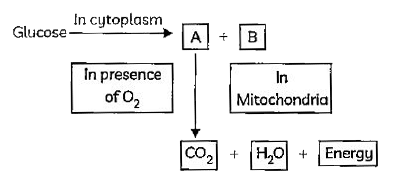The breakdown of pyruvate to give carbon dioxide, water and energy takes place in
a) cytoplasm
b) mitochondria
c) chloroplast
d) nucleus
cytoplasm
mitochondria
chloroplast
nucleus
The correct Answer is:B
Step-by-Step Solution:
1. Understanding Pyruvate Breakdown: The question focuses on the breakdown of pyruvate, which is a product of glycolysis. This breakdown process is crucial for cellular respiration.
2. Identifying the Products: The breakdown of pyruvate results in the formation of carbon dioxide (CO2), water (H2O), and energy (in the form of ATP).
3. Location of the Process: The breakdown of pyruvate occurs in the presence of oxygen, which indicates that it is part of aerobic respiration.
4. Organelle Responsible: The organelle responsible for aerobic respiration, including the breakdown of pyruvate, is the mitochondria. This is where the Krebs cycle (also known as the citric acid cycle) occurs, leading to the production of ATP.
5. Eliminating Incorrect Options:
- Cytoplasm: While glycolysis occurs in the cytoplasm, the breakdown of pyruvate does not.
- Chloroplast: This organelle is involved in photosynthesis, not in the breakdown of pyruvate.
- Nucleus: The nucleus is responsible for controlling genetic information and does not participate in energy production.
6. Conclusion: Based on the above reasoning, the correct answer is b) mitochondria.
---
- Cytoplasm: While glycolysis occurs in the cytoplasm, the breakdown of pyruvate does not.
- Chloroplast: This organelle is involved in photosynthesis, not in the breakdown of pyruvate.
- Nucleus: The nucleus is responsible for controlling genetic information and does not participate in energy production.
Topper's Solved these Questions
- BOOK - OSWAL PUBLICATIONCHAPTER - LIFE PROCESSESEXERCISE - Assertion And Reason Based MCQs17videos
LIFE PROCESSES
- BOOK - OSWAL PUBLICATIONCHAPTER - LIFE PROCESSESEXERCISE - Case - Based MCQs35videos
LIFE PROCESSES
- BOOK - OSWAL PUBLICATIONCHAPTER - HOW DO ORGANISMS REPRODUCE ?EXERCISE - CREATING BASED QUESTIONS6videos
HOW DO ORGANISMS REPRODUCE ?
- BOOK - OSWAL PUBLICATIONCHAPTER - MANAGEMENT OF NATURAL RESOURCES EXERCISE - CASE-BASED MCQs15videos
MANAGEMENT OF NATURAL RESOURCES
Similar Questions
Knowledge Check
- Question 1 - Select One
Breakdown of pyruvate by using oxygen take place in :
ANucleusBMitochondriaCChloroplastDCytoplasm - Question 2 - Select One
The breakdown of pyruvate using O2 takes place in the ____.
AlysosomesBnucleusCvacuolesDmitochondria - Question 3 - Select One
In eukaryotes, the breakdown of complex molecules to yield energy takes place in the
AChloroplastBMitochondriaCCytoplasmDBoth B and C
Does the breakdown of pyrucate using oxygen take place in mitochondria ?
View SolutionThe glucose breakdown pathway in case of aerobic respiration is shown in the flow chart given below.

The breakdown of pyruvate to give carbon dioxide, water and energy takes place inView SolutionCarbon dioxide dissolve under pressure in water to give:
View SolutionIn which reaction a combustible substance reacts with oxygen to give carbon dioxide, water and energy?
View SolutionGaseous exchange of oxygen and carbon dioxide between alveolar air and capillaries takes place by
View Solution

